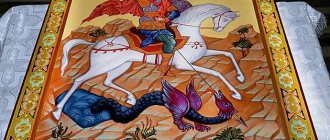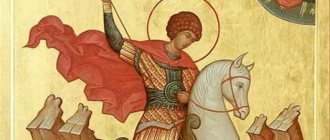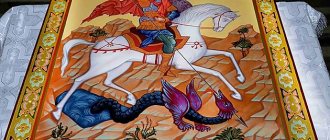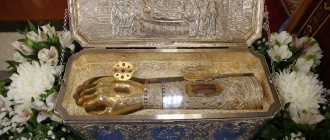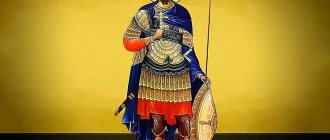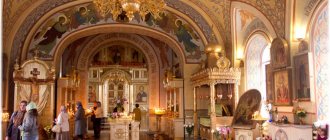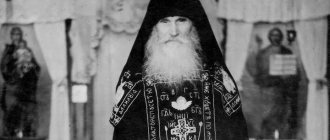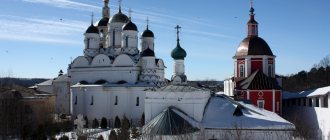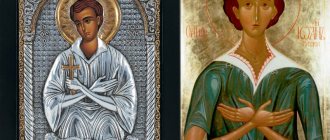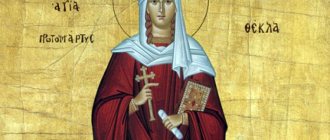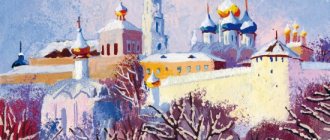Brief life of St. George the Victorious
The great martyr George was born into a family of pious people who raised him in faith in Christ and love. The saint was born in the ancient city of Belit ( modern Beirut
). Having become a real military man, George differed from typical warriors in his ingenuity, courage, handsome appearance and incredible strength. He soon became the commander of a thousand and the favorite of the then emperor Diocletian, a “fanatic” who worshiped the Roman gods.
Hearing about the persecution of Christians by Diocletian, Saint George was filled with pity for them and realized that similar suffering awaited him. He appeared before his patron and admitted that he was a Christian. He cites convincing facts regarding belief in the Lord, but the emperor continued to persuade George to renounce his faith. Then they locked him in prison and placed a heavy stone on his chest. Despite this, the saint tirelessly glorified God while enduring the torment.
George was wheeled around, beaten with whips and ox sinews, thrown onto lime embankments, forced to run in shoes pierced through with nails, but he continued to pray to the Lord. The martyr was sentenced to beheading. He died in 303.
Swan on the head of George
A swan on the head or otherwise used in the picture. Basically, George and the swan are found in large quantities in Neuschwanstein Castle (trans. white swan stone) in Germany. The swan is a symbol of the magician. Also, the white swan is a symbol of rebirth, purity, chastity, proud loneliness, nobility, wisdom, prophetic abilities, poetry and courage, perfection. But most importantly, the swan is a symbol of sincerity, which is higher than the self-interest of the dragon. To defeat a dragon you must have similar qualities.
There are ideas about the ability of the soul to wander through the sky in the form of a swan. Combining two elements: air and water, the swan is a bird of life, and at the same time can personify death. In this regard, the contrast in myths and fairy tales between white and black swans (life - death, good - evil) is interesting. A person with pure thoughts is worthy of the true Grail; Neuschwanstein Castle is also full of his images.
In Ancient India there is “a pair of swans who are Ham and Sa, living in the consciousness of the Great One and feeding only on the honey of the blossoming lotus of knowledge.” The bird Hamsa, or Kalahansa, is “The Swan in Space and Time.” It is also an attribute of the god Brahma - a symbolic bird that drops an egg into Chaos, which turns into the Universe ( a reference to the egg on the crucifixion of Christ ).
Swans also symbolize inhalation and exhalation , breath and spirit. Brahma, the supreme three-faced deity of the Hindu creation, rides on a swan, goose or pheasant. The swan is also associated with the sun; Thus, in the Taittiriya Brahmana, a certain rishi (sage), by the power of his knowledge, turns into a golden swan, flies to the sky and unites with the sun.
The black and white swan, like the horse, is a reference to the caduceus of Hermes, as well as the Sephiroth and Qliphoth .
Posthumous miracles
The relics of Saint George the Victorious are kept in Palestine, in a temple bearing the name of the martyr. The head of the saint was previously kept in a Roman temple, also dedicated to the Victorious. They say that not far from the area where the saint lived, a “snake-eater” of people appeared. Local residents sacrificed people to him to satisfy their hunger. The next victim was to be the daughter of the ruler of Beirut. As soon as the snake began to approach the girl, a young man appeared on a white horse and pierced the monster with his spear. This young man was the Great Martyr George the Victorious.
A later miracle occurred in the city of Ramel. A noble local resident saw the icon of George and the priest reading a prayer next to it. Then the Saracen began to laugh at the clergyman, saying that he was crazy and was praying to the board. He decided to shoot the icon with an arrow, but it did not fly towards the icon - it soared up and stuck right into the rich man’s hand. The pain from this was incredible, the Saracen groaned and suffered. Only prayer in front of the icon of St. George the Victorious and admitting that he was wrong helped him to heal.
One day, the temple near the holy island of Mytilene, dedicated to the Great Martyr George the Victorious, was attacked by Arabs who had heard about the regular ritual of the local residents. Some were able to escape, while others were captured by the Arabs. On the day of remembrance of the saint, the parents of one of the captives arranged a feast; on the same day, his mother, with tears in her eyes, prayed to the saint to deliver her son from captivity. Then the holy great martyr who appeared to him grabbed the guy and sent him home straight to the banquet table.
Great Martyr George the Victorious
Great Martyr George was the son of rich and pious parents who raised him in the Christian faith. He was born in the city of Beirut (in ancient times - Belit) at the foot of the Lebanese mountains.
Having entered military service, the Great Martyr George stood out among other soldiers for his intelligence, courage, physical strength, military posture and beauty. Having soon reached the rank of commander of a thousand, St. George became the favorite of Emperor Diocletian. Diocletian was a talented ruler, but a fanatical supporter of the Roman gods. Having set himself the goal of reviving dying paganism in the Roman Empire, he went down in history as one of the most cruel persecutors of Christians.
Having once heard in court an inhuman sentence about the extermination of Christians, St. George was inflamed with compassion for them. Anticipating that suffering also awaited him, George distributed his property to the poor, set his slaves free, appeared to Diocletian and, declaring himself a Christian, accused him of cruelty and injustice. Speech of St. George was full of strong and convincing objections to the imperial order to persecute Christians.
After unsuccessful persuasion to renounce Christ, the emperor ordered the saint to be subjected to various tortures. St. George was imprisoned, where he was laid on his back on the ground, his feet were put in stocks, and a heavy stone was placed on his chest. But St. George bravely endured suffering and glorified the Lord. Then George’s tormentors began to become more sophisticated in their cruelty. They beat the saint with ox sinews, wheeled him around, threw him into quicklime, and forced him to run in boots with sharp nails inside. The holy martyr endured everything patiently. In the end, the emperor ordered the saint's head to be cut off with a sword. Thus the holy sufferer departed to Christ in Nicomedia in 303.
The Great Martyr George is also called the Victorious for his courage and spiritual victory over his tormentors who could not force him to renounce Christianity, as well as for his miraculous help to people in danger. The relics of Saint George the Victorious were placed in the Palestinian city of Lida, in a temple bearing his name, and his head was kept in Rome in a temple also dedicated to him.
On the icons of St. George is depicted sitting on a white horse and slaying a serpent with a spear. This image is based on legend and refers to the posthumous miracles of the Holy Great Martyr George. They say that not far from the place where St. George in the city of Beirut, there lived a snake in the lake, which often devoured the people of that area. What kind of animal it was - a boa constrictor, a crocodile or a large lizard - is unknown.
To quench the fury of the serpent, the superstitious people of that area began to regularly give him a young man or a girl by lot to be devoured. One day the lot fell on the daughter of the ruler of that area. She was taken to the shore of the lake and tied, where she waited in horror for the snake to appear.
When the beast began to approach her, a bright young man suddenly appeared on a white horse, struck the snake with a spear and saved the girl. This young man was the Holy Great Martyr George. With such a miraculous phenomenon, he stopped the destruction of young men and women within Beirut and converted the inhabitants of that country, who had previously been pagans, to Christ.
It can be assumed that the appearance of St. George on horseback to protect the inhabitants from the serpent, as well as the miraculous revival of the farmer’s only ox described in the life, served as the reason for the veneration of St. George as the patron of cattle breeding and protector from predatory animals.
In pre-revolutionary times, on the day of remembrance of St. George the Victorious, residents of Russian villages for the first time after a cold winter drove their cattle out to pasture, performing a prayer service to the holy great martyr and sprinkling houses and animals with holy water. The Day of the Great Martyr George is also popularly called “Yuriev Day”; on this day, before the reign of Boris Godunov, peasants could move to another landowner.
St. George is the patron saint of the army. The image of St. George the Victorious on a horse symbolizes the victory over the devil - the “ancient serpent” (Rev. 12:3, 20:2). This image was included in the ancient coat of arms of the city of Moscow.
November 10/23 – Wheeling of the Holy Great Martyr George
Georgia, enlightened by the Christian faith by Saint Nina Equal to the Apostles († 335), a relative of the Holy Great Martyr George the Victorious († 303, Comm. April 23), especially honors Saint George as its patron. One of the names of Georgia is in honor of George (this name is still preserved in many languages of the world). In honor of the Great Martyr, Saint Nina established a holiday. It is still celebrated in Georgia on November 10 - in memory of the wheeling of St. George. In 1891, in the Caucasus, near the village of Kakhi, Zagatala district, a new temple was built on the site of an ancient one in honor of the Holy Great Martyr George the Victorious, to which many pilgrims of different faiths flock.
November 3/16 – Consecration of the Church of the Holy Great Martyr George in Lydda
The city of Lydda (Lod) is the birthplace of the Great Martyr George the Victorious. This was his mother’s house, this is where he spent his childhood. The Holy Great Martyr George was a Roman soldier; he suffered under Emperor Diocletian in Nicomedia at the beginning of the 4th century. Christians transferred his relics to his homeland, to Lydda, and here he was buried.
The tomb in which the relics of the great martyr were placed is now located in the crypt of the Orthodox church dedicated to the Great Martyr George. In the temple itself there is a particle of the relics of St. George, as well as the chain with which the great martyr was bound.
The first church was built here in the 6th century. The temple was destroyed several times and was restored in its current form only in 1872 thanks to donations from Russia. The consecration of the renovated temple took place on November 3/16, 1872, the anniversary of the day on which it was consecrated for the first time. The Russian Church commemorates this significant event on this day and to this day; this holiday was included in the month, in honor of this celebration, churches were built in Rus'.
Also in Lydda, the Apostle Peter healed Aeneas, who had been lying sick for eight years (Acts 9:32-35).
November 26/December 9 – Commemoration of the consecration of the Church of the Great Martyr George in Kyiv
Russian princes, starting with Equal-to-the-Apostles Prince Vladimir, had a pious custom of founding churches in honor of their Guardian Angels. Thus, Equal-to-the-Apostles Vladimir, in Holy Baptism Vasily, built churches in Kiev and Vyshgorod in the name of St. Basil the Great, Prince Izyaslav I (1054–1068), in Baptism Demetrius, built a temple and monastery in Kiev in the name of the Holy Great Martyr Demetrius (October 26 ), Prince Yaroslav the Wise (1019–1054), in Holy Baptism George, laid the foundation for a temple and a men's monastery in honor of his Guardian Angel, the Great Martyr George (April 23), and also built a temple in the name of the Great Martyr Irina (May 5), Guardian Angel of his wife. The temple in honor of the Great Martyr George was located in front of the gates of Hagia Sophia, Prince Yaroslav spent a lot of money on its construction, and a large number of builders took part in the construction of the temple. On November 26, the temple was consecrated by Saint Hilarion, Metropolitan of Kyiv (October 21), and an annual celebration was established in honor of this event.
See also: “ The Suffering of the Holy Great Martyr George the Victorious”, “ Consecration of Memory of presented Demetrius of Rostov.
What do people pray to St. George the Victorious for?
St. George the Victorious is considered the patron saint of the military; he protects everyone who is in one way or another connected with military service. Saint George is the patron saint of all men named Yuri and George. Despite this, you can pray to him in other matters. For example, people engaged in agriculture who want to protect livestock from diseases or get rid of crop failure can turn to him with prayer. They pray to the saint when they want to achieve peace on earth and gain victory over their enemies. Often women turn to him who want to get rid of female diseases - and there is a lot of information about such miracles of healing.
We recommend paying attention to suitable icons: Handwritten icon of the Miracle of George about the serpent 40 (Size 27*31 cm)
65 000 ₽
More details Handwritten icon of St. George the Victorious
17 500 ₽
More details Handwritten icon of the Miracle of George about the serpent 13
25 500 ₽
More details
City, People, Woman holding a dragon or standing near it
In the original historical version, the woman is a princess captured by a certain enemy who is terrorizing the land and the kingdom of a certain pagan king in Beirut (trans. well, abyss). However, when rethought, it looks with a different meaning.
In the presented samples of paintings, we see how the crowned woman has a connection with the dragon, which can be seen from the rope. The woman and the dragon depend on each other and need each other for some kind of compensation.
- To me, a woman seems to be the psyche or creative potential of a person. She is, as it were, a hostage of the dragon, but also, as it were, his involuntary mistress.
- The city in the background is the construction of the mind in the human brain - thinking patterns, algorithms, clichés, concepts.
- People on the walls of the city are thoughts, service personnel of thinking of different hierarchies.
The woman is the guardian and head of the human city in the background. She is the Queen of the Earth - mental sanity, the queen of the mind. Her city or kingdom is the Earthly or cerebral kingdom.
The woman worries about the monster, since she is responsible for its existence. The necessity of evil or sin in the Earthly Kingdom is a necessity. No matter how much the Victorious defeats the creature, it is still immortal. In fact, it cannot be killed, only pacified with a spear of “intention” (the preferred option) or driven into a fissure in the ground by the “subconscious” (less preferable). So the woman is worried about what the Victorious will do - balance himself or ban his dark side in the abyss well. Indeed, in the latter option, this is what other residents in the city usually do, contemplating what is happening from the towers, like the inertia of mental patterns without meaningfulness and thoughtfulness.
The captive princess is an allusion to various myths and legends about the descent into Hell or Hades, the Underground Kingdom of the Dead (and the same Persephone, Ishtar, Orpheus, etc.). The princess is the first half of a person’s life, and George is the second. That is, there is a need to go through your dark essence for some time, to know it “from” to “before”, and then to go through the ascent of your soul and victory over the serpent.
Prayer to St. George the Victorious
Holy, glorious and all-praised Great Martyr George! Gathered in your temple and in front of your holy icon, people worshiping, we pray to you, known to the desires of our intercessor, pray with us and for us, beseeching God from His benevolence, that He may mercifully hear us asking for His goodness, and not abandon all ours to salvation and life needful petitions, and grants our country victory in the face of resistance; and again, falling down, we pray to you, holy Victorious: strengthen the Orthodox army in battle with the grace given to you, destroy the forces of the rising enemies, so that they will be ashamed and put to shame, and let their insolence be crushed, and let them know that we have Divine help, and to everyone in sorrow and the current situation, show your powerful intercession. Pray to the Lord God, the Creator of all creation, to deliver us from eternal torment, so that we glorify the Father, and the Son, and the Holy Spirit, and we confess your intercession now, and ever, and unto the ages of ages. Amen.
Spear piercing monster
This is the same spear as on the crucifixion of Jesus Christ (Saving Harmony), only here it has the opposite meaning. Here our Victorious Jesus is in a state of resurrection and he controls the spear, and it is not the spear that paralyzes his will. This means that in his hands there is no longer doubt and a challenge to higher powers, but a divine intention to overcome his weaknesses.
Here one takes one’s life into one’s hands in the literal sense, here one accepts one’s fate and bravely resolves to fulfill one’s true destiny, here the fate of a permanent loser changes to the fate of a lucky one in any situation. The spear is a lever with which you turn your inner world, views and self-application over. What was previously considered shackles and a pit of destruction is now a means to the Top.
Crown or angel with crown over George's head
This is a reference to the divine triangle ( Kether, Hochma, Binah ), as well as specifically to the Sephira Kether (translated as crown, crown). This is the power of the personal Higher Immortal Self over the mind of the earthly George (human farmer). Essentially it means the sanity and adequacy of the actions of the Victorious.
Description and ancient interpretation of the victory over the monster
- symbol of the victory of Christianity, deliverance from paganism;
- a symbol of victory over evil, over sin, over the devil;
- symbol of military courage;
- a symbol of the victory of Russian troops over their enemies;
It turns out that the saint not only saves the princess from death, but also the entire pagan people from spiritual death. Gradually, the plot of St. George defeating the serpent begins to be considered a military symbol.
St. St. George the Victorious
It can be found on coins and seals. In addition, it became the official coat of arms of Moscow and part of the coat of arms of Russia. For the first time, a horseman killing a snake became a symbol of the Moscow principality after the victory in the Battle of Kulikovo.
9
May
1994
A memorial church was founded in honor of the Victory in the Great Patriotic War next to the memorial on Poklonnaya Hill. Construction was carried out using city funds.
Life
Childhood and youth
He was born into a Christian family in Cappadocia at the end of the 3rd century. At an early age he was left without a father. Being a faithful Christian, he died as a martyr. The mother took her son to her homeland in the city of Lydda (modern name - Lod, Israel).
Interesting fact
It was in this city that George was later buried. Currently, the saint’s tomb is located under the Orthodox church built in his honor. Some of the remains of the great martyr and the chain that he was wearing in prison before his death are kept there. It is believed that it cures mental illness.
From childhood, his mother instilled in the boy a love for Jesus Christ, helped him get a good education and left a rich inheritance.
Military service
George entered military service, where Emperor Diocletian drew the attention of the brave young man. Already at the age of 20, the young man received the honorary title of commander over a thousand warriors.
Arrest
Being a pagan, the emperor intensified the fight against Christians (this fact is known in history as the “Great Persecution”, the last and most severe persecution of believers in Jesus in the Roman Empire in the early 4th century). Georgy could not stay away. He gives away all his property, frees his slaves and reveals his faith to the emperor, which means certain death for the saint. Diocletian called on him to renounce Jesus, but when he refused, he ordered his arrest and torture.
Torture and wheeling
When the guards took him to prison, their spears began to bend and break as soon as they touched the body of the condemned man. The emperor became even more angry and ordered his former warrior to be wheeled on the wheel. He was tied to a wheel. At the bottom they installed boards with sharp iron tips, which tormented the prisoner’s body as they rotated. Despite the severe torment, George prayed to the Lord and thanked him. And when everyone thought that the saint was dead, an Angel appeared and healed him.
Useful materials
The pagans who witnessed the miracle believed, but the emperor only became even more angry. The brutal torment of the prisoner lasted 8 days. He was covered with quicklime, tortured with a hot iron, beaten and even forced to drink poison. But nothing worked. The Lord saved his devoted follower every time, and even helped him resurrect the dead.
Execution
On the eve of the execution of the martyr. The Lord visited George, calmed him down and laid a crown on him. The next day the saint's head was cut off.
Along with the great martyr, the emperor's wife Alexandra was also executed. The miracles that happened to the prisoner inspired her to renounce paganism, for which she was punished by her husband.
